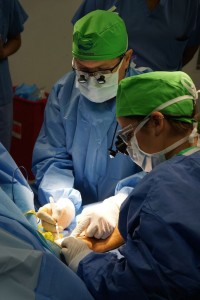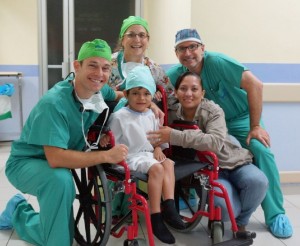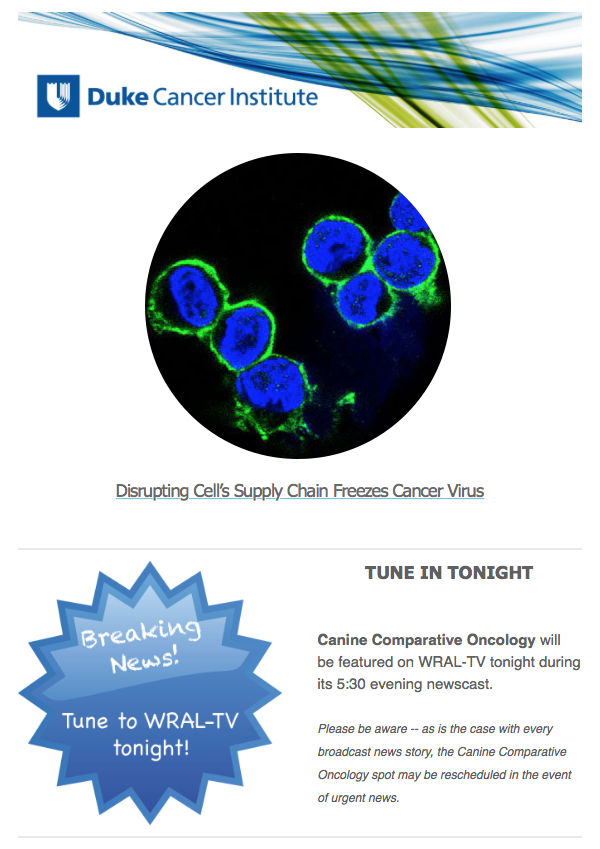“As you grow older, you will discover that you have two hands, one for helping yourself; the other for helping others.” – Audrey Hepburn

The THP team included (numbered from left to right): 1- Marcy Tucker, MD; 4 – Chelsea Leversedge; 6 – Scott Kozin, MD; 7 – Fraser Leversedge, MD; 9 – Jeremy Miles, MD
This past September, Duke hand surgeon and Vice Chair of Education, Fraser Leversedge, MD; Scott Kozin, MD (Duke Class of 1982); current Duke hand fellow, Jeremy Miles, MD; and Marcy Tucker, MD, PhD, a Duke Ambulatory Surgery Center anesthesiologist, along with physicians and nurses from around the country, travelled to San Pedro Sula, Honduras, for six days as part of the Touching Hands Project (THP). The Touching Hands Project was the vision of Dr. Kozin and was developed during his presidency of the ASSH in 2014. THP is coordinated by the American Society for Surgery of the Hand and its Foundation and currently sponsors 8-10 mission trips per year to underserved regions around the world.
The Honduras brigade was based at the Ruth Paz Hospital and Clinic where they treated both adults and children and participated in several community events.

The THP team provided care for adults and children involving microsurgical skills to basic fracture care, and from complex wound reconstruction to the treatment of tendonitis and arthritis related conditions
Day 1 began with a pre-mission planning conference, where the THP team went over the week’s itinerary and safety precautions. Later that day, the team saw 65 patients at the inaugural Ruth Paz foundation THP clinic. Eighteen pediatric surgical cases and 28 adult cases were performed over the week; many cases involving chronic and disabling injuries such as burn injuries, machete injuries, gunshot wounds, nerve and tendon injuries, fracture malunions, and congenital deformities. Two operating rooms, with two operating tables per room, were utilized full time throughout the week.
On Day 2, the THP team treated an 8-year-old boy with substantial healed burn scars over most of his body from a house fire. They later performed web space reconstruction surgery (using local flaps) in a subsequent procedure to address the web-creep restricting the motion of his 2nd, 3rd, and 4th web spaces. Several open wounds and chronic flexor tendon injuries required reconstruction.
The caseload on Day 3 ranged from a trigger finger on a two-year-old, to median nerve grafting, arm fractures, and machete injuries to the hand.

Jeremy Miles, MD (left), a current Duke Hand Surgery fellow was able to gain invaluable pediatric/congenital hand surgery experience working with Scott Kozin, MD (right)
On Day 4, the THP team visited a local orphanage. Upon arrival, the team was excitedly greeted by children ranging in age from 4 to 13 years. After playing a competitive soccer match with the children, the team enjoyed dinner with the founder of the Ruth Paz Clinic and daughter of Ruth Paz, Mary Ann.
On Day 5, the team performed 8 surgeries, including two brachial plexus palsy cases. The first was a 3-year-old boy with a neglected, upper-trunk birth palsy who lacked shoulder external rotation. He had marked
improvement in functional arc of motion after a humeral osteotomy. The second patient was a 45-year-old male with a traumatic injury involving nerves C5 thru C7 that required nerve transfers.

Dr. Leversedge provided care for numerous patients with chronic tendon and nerve injuries during the THP visit to Honduras
On the final day, the THP team performed eight cases in two rooms. During the day, various items were packed and tallied. The team rounded one last time, making sure post-operative plans were well-detailed for the local orthopaedic surgeons, who perform follow-up visits with patients treated by the THP. A strategy for communication between the local surgeons and clinic and the senior THP surgeons was established.
During the THP’s trip, 42 cases were performed and 73 patients were evaluated.
Dr. Leversedge will be returning to Honduras as team leader for the THP in Spring 2016, and is eager to continue helping those less fortunate and to make a positive impact on the global community. Six members of the Duke medical community are committed to the multi-institution trip already!











